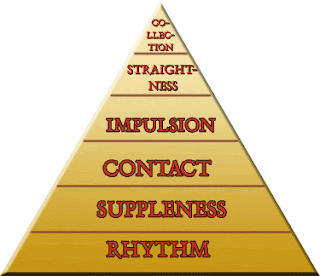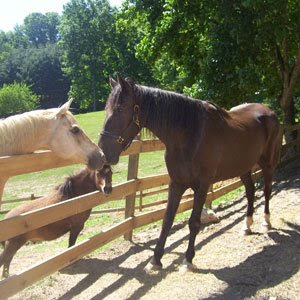Yesterday, Shorty and I took the day off from riding. Instead, I took him for a walk around the field. I let him
hand graze for about twenty minutes near the "scary car zone" as a sort of reinforcement that cars will not jump through the trees and eat him. We explored the property (about 12 acres in all) and made frequent stops for nibbling grass. Shorty found a jackpot of white clover and was so excited he grunted as he furiously tore into the little patch. While he grazed, I groomed the itchy spot under his jaw. If we was a cat instead of a horse, he would have purred.
All of that came tumbling down in a matter of minutes when we walked over to riding arena, where a group of summer camp students were riding in their lesson. I managed the 2008, 2007, and 2006 summer camp seasons and taught an average of ten hours a day. This year, I have a full time job that offers more
opportunities and much higher pay, plus I'm not getting burned out on kids peeing their pants and throwing up their
sandwiches while riding. The instructor, we'll call this one B, was praising one of the students for her great hands. Great hands? Hardly. Her hands were about a foot too high and yanking back with ferocious pressure. I had to take Shorty back to the barn and put him away because I was getting so upset.
The worst part? The riding instructor encouraged her to "half halt" the horse if he went too fast. She described a half halt as a "sharp, upward jerk back on the reins." If I were a cartoon, steam would have errupted from my ears, because my brain basically fried when I heard that. The student's posting was absolutely awful; the girl pulled up on the horse's mouth as she rose, causing the poor, old, loyal school horse to hollow, invert, and chew the bit furiously. When she came down, she SLAMMED down on the seat, and she was not a lightweight girl. The cherry on top was when B praised the girl for being on the correct diagonal, and she
wasn't.
When the lesson was over, one camper's mother praised the girl for "great seat" and the student beamed. B chimed in with "Yeah, and great job posting today." Meanwhile, I'm over at my locker, furiously scrubbing dirt off of Shorty's cribbing collar because I want to say something, start something, do something but I can't because there are so many kids and horses around. In my head, I imagined myself putting a bit in B's mouth and having her student with "great hands" rip her around for an hour. I wanted to give the old loyal school horse a hug and a cookie (I teach lessons on him, and depend on his good nature to give my students a good start in their careers).
The girl doesn't deserve praise for her riding. I found out she's been riding for four months now and is A. just now learning how to post, B. still hasn't been told not to pull too hard on the reins, and C. worse equitation-wise than the student I started last week in her first lesson ever. She's also 12. At that age, deep down, I feel that she should at least feel that something is wrong with her horse's head, and that horses don't typically choose to pop above the bit and suck behind a rider's leg the way old
JT did. I admit, there could be a mental issue there that prevents her from reasoning correctly, but if that is the case she should not be riding in a group. I would put her in lesson on her own and stick her on a
lounge line for a while, and I would give her reins with elastic inserts (or reins made of string that will break), and get a fat
rubber snaffle for the horse. While I believe that horses can teach us powerful lessons about patience, quiet equitation, confidence, balance, etc. and offer TONS of great exercises for physically and mentally
handicapped people, this issue isn't being addressed the right way.
So here I am. And, as I type this, B is finishing up with her campers for the day, and she'll spend tomorrow with them as well. I do have a bit of sway with the barn owner, and, after three years of employment and several degrees/certifications/times I was proven right, he has expressed that among his staff I am the senior instructor. Addressing the B situation will be difficult. She's not a good instructor, and unlike A she doesn't listen well for learn from her mistakes. For example, I've had to teach her how to put polo wraps on three times now, and yet, when I walk in the barn, horses she wraps have
velcro around their coronet bands and there's a tail of extra material at the top (*
headdesk*). I've already recommended that the student not ride on her own any more. If she wants to continue, great, but she needs constant attention whenever she is around a horse- that much is clear. Now, do I go for the jugular and recommend that B gets fired?
I'm really at a loss on the whole situation. On one hand, I have ignorant B, who has proven she's stuck in her old ways, not that I'm not either, but at least I have an education and you'd best believe I listen attentively when someone with more credentials/credibility/professionalism/proven track record has something to suggest to me. On the other? B is the only teacher available for the summer camps, and I know firing her will put my boss in a bind because A and I work during the day. Plus, some kids have really grown to like her and she'd probably take them with her. I'm not in charge of the business, but, as a business person, I know it will hinder my boss's meager earnings, which have already suffered due to the recession.
Readers, I am asking for your comments on this one. What would you do?






